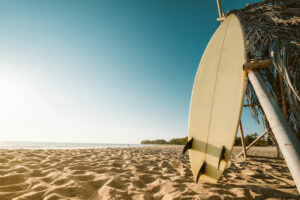Looked at from the outside, the world of windsurfing might seem intimidating and almost impossible to enter. But letting your fear keep you from experiencing the thrills and joys of the combined powers of wind and water? Never! In only 5 minutes, we will provide you with the most important information on how to windsurf. Learn the essential techniques, get gear recommendations, safety tips, and everything you need to start the adventure today.
In this article, you will get answers to the following questions:
- Which equipment do you need?
- How to read the wind?
- Where are the best windsurfing spots for beginners?
- How do you get on the board?
- And what techniques can help to get control over the board?
How to choose the right Equipment?
When surfing classically out in the ocean, you are bound to the direction and power of the waves. Windsurfing – not to be confused with kite surfing – requires, besides the board, a rig.
Built like a sail, the rig comes in different sizes and types. From a smaller handy version to the bigger and more sturdy rigs for advanced riders.
In the beginning, it’s recommended to start with a bigger board and a smaller rig to enhance your balance. Correlating with the learning process, you can adapt the size of the board and rig.
Technical Terms
Ever sat in a class, listening to the teacher explaining a task, only understanding every second word and wondering whether you accidentally booked the course in Dutch? We’ve probably all been there once or twice.
To avoid wasting the precious time of your surf class with googling, which part of the material the teacher is currently referring to, here is the main vocabulary listed up for you.
→ Rig: The rig is what you call the whole set up, besides the board. It includes the mast, the sail, and the boom.
→ Daggerboards: This special kind of centered boards come with a bigger rectangular fin in the middle of the board’s bottom. It gives the board more stability, making it more resistant towards side pressure.
→ Boom: The boom is the horizontal bar that you hold on to while windsurfing, allowing you to control the sail.
→ Mast: The mast holds the sail upright and connects it to the board.
→ Uphaul: The uphaul is the rope you need to pull the rig out of the water.
→ Harness: This safety device is the belt, connecting your body and the rig.
→ Battens: Battens are rods, stabilizing the sail.
→ Luff: This is what you call the side of the sail next to the mast.
→ Leech: This refers to the other side of the sail, the furthest away from the mast.
Finding the right size
If you have tried out a couple of other surfing styles, you will know that the right board size can make the difference between smoothly surfing or just struggling to even stand up.
In the case of windsurfing, we have the luxury of harnessing the power of the wind. It is no longer necessary to focus on the size, strength, and direction of the waves, as your sail will handle over half of the work.
The only important rule is: be comfortable. As a beginner, you will have a much easier start if you start with a bigger board and a smaller sail. With the bigger board, balancing and getting on the board will be much easier. The smaller sail takes away some pressure of the wind and guarantees a smooth but not too fast ride.
As for the harness and foot straps, they are mostly adjustable. Make sure that they fit your feet and waist snugly, and you will be good to go.
Preparation – 5 Easy Steps
From the surf shop into the water, only 500 meters and 5 easy steps are separating you from the thrill of falling into the waves for the first time. And to dispel that illusion right away… Yes! Everybody falls on their first try.
Step 1: Choosing the location
Finding the perfect mixture of calm water and the right amount of wind can be tricky. A lagoon or a lake would be perfect. If you, as we highly recommend, enroll in a surf lesson, the instructors will show you good spots and provide information about the wind and possible dangers in the area.
If you want to go by yourself, it is important to find a place where no powerboats or other larger ships disturb the water and create waves. That will only make it unnecessarily hard to maintain your balance.
Furthermore, the wind plays a significant role. Look for a spot where the wind blows parallel to the shore, making sailing in and out of the water as easy as possible. Also, if there are trees or houses close to the shore, they may cause the wind to swirl and make it difficult to keep the sail full.
Step 2: Get your equipment ready
Once you’ve found the location, it’s time to prepare your board and rig. If it’s your first time windsurfing, you can get a sense of how the wind will feel when you’re on the waves by practicing on land. Ensure the fins are removed to prevent damage when pushing into the ground.
The plug, where you connect the rig and board, should be free of sand to avoid unnecessary wear and tear. Secure the rig in its holder and leave it lying on the ground, just as it would be in the water.
Now that the board is set up, place your feet centered on either side of the mast and pull the uphaul until you can grab the boom. Can you feel the wind pulling on the rail? Whenever you feel like you’ve found your balance and want to try it out in the water, carefully step down, install the fins, and activate the daggerboard.
If you ever feel like slipping off the board at any second, you can take a handful of sand and rub it on the deck. The deck should not look rough, it should just not feel slippery. The longer your board is used, the better the deck’s traction will become.
Careful!
Don’t lie on the board after using tanning oil, as it will cause the board to be slippery.
Step 3: Reading the wind
Understanding the wind directions is crucial in windsurfing. Here are some basic tips for reading the wind:
1. Watch the direction: Look at the movement of the trees, flags, or ripples on the water to determine the direction of the wind.
2. Feel the wind on your skin: Stand facing the wind and feel the direction and strength of the wind on your face.
3. Wind indicators: Windsocks or wind indicators at the beach can provide valuable information about the direction of the wind and speed.
4. Check online weather forecasts: Wind speeds over 7 miles per hour can be tough to handle as a beginner. Better aim for 3–5 miles per hour.
There are two main terms, describing the direction of the wind.
Offshore – When the wind blows from the land or in a direction moving away from the shore and out to the water, it is referred to as “offshore” wind.
In this case, the wind is blowing from the land towards the sea or ocean. Offshore winds are generally considered favorable for water sports like surfing and windsurfing because they create clean and well-defined waves. The wind blowing from the land helps to hold up the wave faces, making them more organized and easier to ride.
The counterpart to the water directed wind is called “onshore” wind.
Onshore – Here, the wind is blowing from the sea or ocean towards the shore. Onshore winds can make the water surface choppier and can create messy and less organized waves. For surfing and windsurfing, onshore winds are typically less desirable because they can make wave riding more challenging and thus less enjoyable.
The perfect middle ground would be the wind blowing parallel to the shore. This makes it easier, especially for beginners in windsurfing, to avoid drifting too far from the shore and ensures a calm water surface.
Step 4: The first ride
The location has been chosen, the material is prepared, and the wind direction determined. It is time to put your windsurfing skills to the test. You start by pushing your board out in the water till it is deep enough for the fins.
When swimming out, the rig lies flat on the water, floating along. Once you reach a spot, about 50 meters away from the shore, it is time to align the board. Check the wind direction once more and position the board vertically to it with the sail pointing in the same direction the wind blows.
Remember to keep your back towards the wind. Most windsurfers sail back and forth at 90 degrees to the wind, this is called sailing across the wind. This technique allows you to harness the wind’s power effectively and navigate with ease.
The next step will be climbing onto the board – no need for elegance! Place your knees on the board, grab the uphaul, and carefully try to stand up. Slightly bend your knees and start hauling in the rope. If your back starts hurting, you are probably bending over too much.
Step 5: Practice steering
Place both hands on the mast. This position is called “safety position”. It gives you maximum control while using next to no energy. Now, slightly move the mast to the left and let your body find balance naturally, the board will follow. This way, you can effortlessly spin clockwise.
Leaning towards the right will transfer the movement through your legs into the board, making you spin counterclockwise.
Tip
The stronger the wind and the further you move the mast, the faster the turns.
The two main Techniques in Windsurfing
It is time to delve deeper into the world of theory. Windsurfing is all about mastering the right techniques. Once you have figured out how to pull the sail and adjust your balance in order to move in the direction you desire, it will feel like playing with the elements.
Body Position
Maintaining the correct body position on a windsurfboard is essential for balance, control, and efficient sailing. Here are the key points to consider for a proper body position:
- Feet placement: Position your feet shoulder-width apart and parallel to the centerline of the board. Keep your weight distributed slightly more to the back foot to maintain balance.
- Knees: Keep your knees slightly bent, which allows you to absorb shocks from choppy water and provides better control over the board.
- Upper body: Lean back until your arms are no longer bent. Your body should resemble the shape of the number 7, giving this position its distinctive name – “Number 7”.
- Shoulders and hips: Face your shoulders and hips forward in the direction you want to sail. This helps maintain stability and enables better control of the sail.
Tip
Look forward! Your gaze determines where your board will be going. Just like when riding a bike, skiing or any other activity – eyes on the prize!
Technique No. 1: Tacking
Tacking is a fundamental maneuver in windsurfing used to change the direction of the board while sailing upwind. It allows windsurfers to navigate against the wind, which is crucial for getting back to your starting point or reaching destinations upwind.
Upwind: When sailing upwind, you are going in a direction, where the wind is blowing directly towards you from the opposite side.
To do so, after figuring out in which direction the wind blows, put pressure on your back foot. This will cause the board to tilt to the side of the board facing the wind into the water.
After starting to turn, you will release the pressure on the sail by letting it slowly go. This is called “sheeting out”. As the board turns through the wind, the sail will naturally start to switch sides. Quickly step over the mast to the other side of the board.
Once you’ve crossed the wind and are on the new upwind side of the board, start “sheeting in” the sail. Pull the sail towards you to catch the wind on the new side and generate power.
Technique No. 2: Jibing
Jibing is the opposite of tacking and is used to change direction while sailing downwind. It is considered the easier way because the wind will not work against you during the maneuver.
Downwind: When sailing downwind, you have the wind in your back and are moving in the same direction as the wind does.
It is only in one aspect the opposite of tacking. You start by shifting your weight further towards the front foot, what will cause the board to turn the board’s downwind rail deeper into the water.
From here on, the procedure will be exactly the same. Sheeting out, letting the sail go loose, followed by crossing the wind and stepping around the mast to the other side of the board, finishing the turn with sheeting in and sailing off.
Jibing and tacking require practice and finesse, but with time and experience, you’ll master this maneuver fluidly. Happy sailing!
Conclusion: Learning Windsurfing for Beginners
Despite the initial challenges, learning how to windsurf is an adventure, more than worth a try. As you progress through the lessons and master essential techniques, you’ll experience the thrill of standing confidently on the board, feeling one with the elements. Windsurfing not only offers a fantastic way to stay active and connected with nature but also fosters a sense of achievement as you ascent to new challenges and explore stunning destinations. Remember, with determination and a willingness to learn, the windsurfing world is yours to conquer – where the wind becomes your ally, the waves your canvas, and every moment a celebration of the indomitable spirit of adventure.
FAQ – Most asked question about windsurfing
Especially for beginners, going out into the ocean with a windsurf board is extremely dangerous. There are too many obstacles, such as people and boats, strong waves and unpredictable winds. Besides that, starting on a calm lake will be most likely challenging enough.
Once you got a hang on the different techniques, riding the wind will look almost effortless. However, let’s be brutally honest – windsurfing is a tough sport. You need to be quick, and you will have to not only use your arms, but your whole body to steer. But don’t get discouraged – reputable surf schools will not only select suitable spots based on your skill level but also provide guidance to ensure proper body positioning, preventing back and shoulder cramps.
The three most common mistakes are: The wrong body position – avoid sticking your bum out, it not only looks funny, but will take a toll on your lower back as well. Secondly, pulling your sail too close – this will make it unnecessarily hard to maintain balance and also prevents the wind from catching the sail properly.
Thirdly, being scared of failing – falling is inevitable, and it happens to everyone, including skilled surfers. But you know what? It is part of the process, and you might say: If you didn’t fall, you most likely didn’t learn anything new that day!









